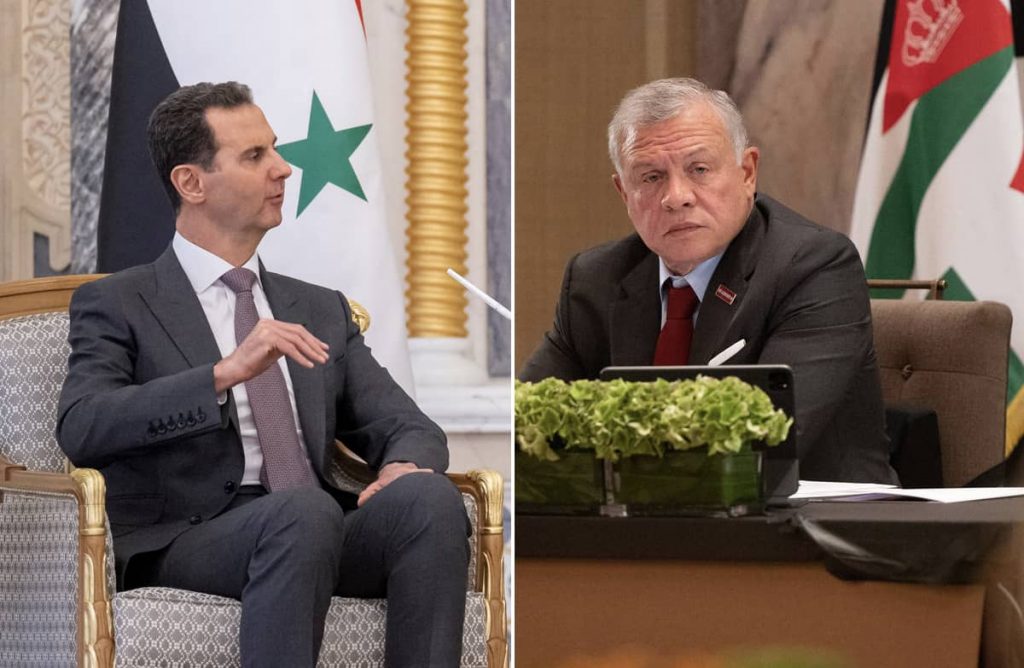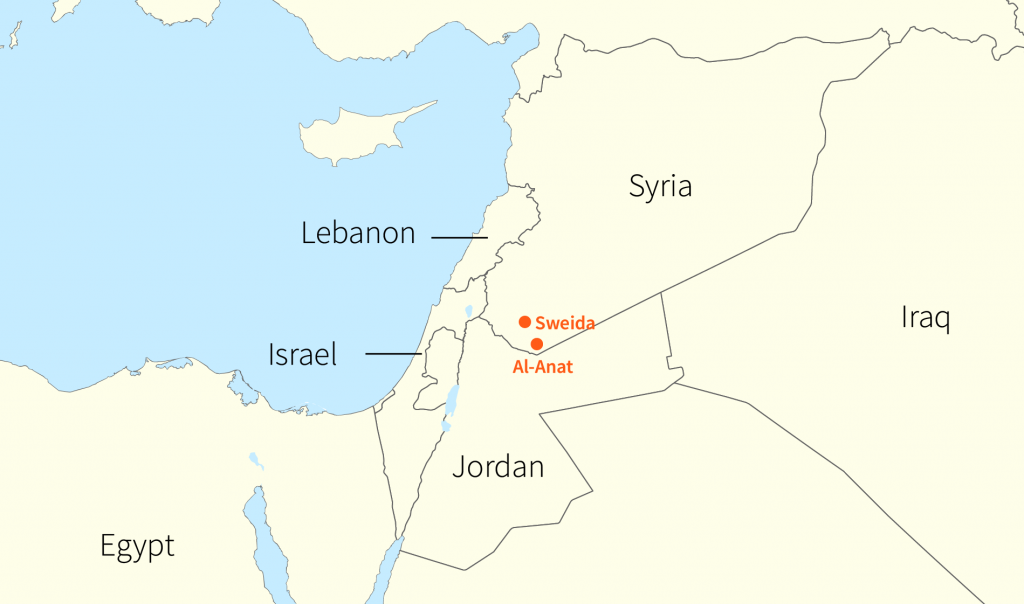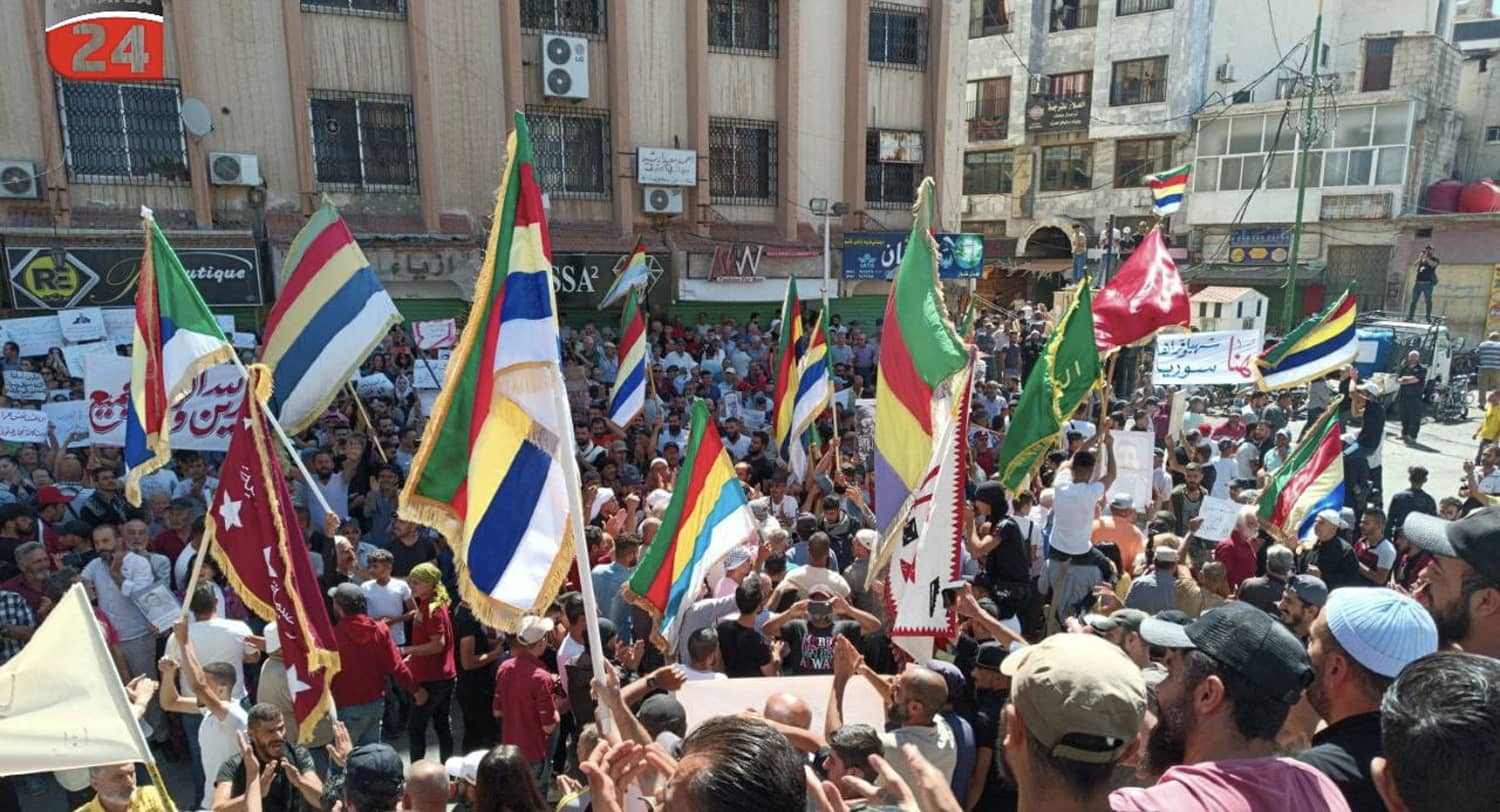On August 20, a majority of the previously quiescent Druze minority in Syria moved to open revolt. Chanting slogans to topple the government, demolishing statues of Bashar al-Assad and tearing down his billboard portraits, thousands of protestors spread from the main square of the provincial capital of Sweida to most Druze townlets and villages. On September 11, the birthday of Assad, the crowds chanted, “We will see you in the Hague (a reference to a future war crimes trial.)
The Druze became the first minority group in the Syrian complex sectarian mosaic to demand Assad’s ouster.
At roughly three percent of the pre-civil war population of the country, the Druze of Syria are concentrated in one province in the country’s southwest, Sweida province (named after its largest city), an area historically known as Jebel al-Druze. Currently it is estimated to have a population of almost half a million people, down from 770,000 at the outbreak of the civil war in March 2011.
The Druze of Syria were traditionally loyal to the Syrian ruling Baath Party. Furthermore, the increasingly jihadist character of the largely Sunni armed insurgency deeply concerned the Druze. For them, the fall of the Baathist regime meant the prospect of facing a radical Islamist government, and thus the Druze chose to remain neutral: not enlisting in compulsory military service while abstaining from initiating confrontation. The revolt of late August of this year constitutes a dramatic departure from this neutrality towards what may prove to be a final divorce from the regime.

The Druze Concerns
The disillusionment of the Druze with Assad, their suspicion of militias backed by Iran and Hizbullah on the outskirts of their region, and growing economic hardships are fanning the flames of revolt. In Syrian Druze circles, there is now open discussion of “self-rule,” for example replacing government offices and services with local Druze alternative bodies.
It is quite telling that one of the first to advocate Druze autonomy was retired Syrian Brigadier General Nayef al-Aqel, regarded by the Assad regime as a war hero for allegedly planting the Syrian flag atop the Israeli intelligence installation on Mount Hermon, captured briefly by the Syrian army in the 1973 war. During the second week of the protest in August, his proposal to establish a new council, composed of all Druze factions, to administer the province was rejected by Sheikh al-Aql (spiritual head) of the Druze in Syria, Sheikh Hikmat al-Hijri. Yet, the idea of some form of autonomous governance keeps gathering support.
By early September, Sheikh Hijri was proclaiming on video a “jihad” (holy war) against Iran’s and Hizbullah’s militias whom he defined as “occupiers.” He also attacked the ruling Ba’ath party and denounced the killing of three demonstrators in front of the Baath offices in Sweida. Hijri offered his blessing to the protesters and urged them to insist on their demands. (It should be noted that one of the other two Syrian Druze spiritual leaders, Sheikh Jarbua’a, still sides with Assad, though he has a much smaller following.)
Different armed Druze groups in Sweida started patrols in the province, enlisting volunteers especially among the 20,000 defectors from Assad’s army. Most noteworthy among them is Rijal al-Karama (“the Men of Dignity”), established in 2012 by Sheikh Wahid al-Ba’alus, who was assassinated by Assad’s agents in 2015. Pictures of Sultan al-Atrash, the leader of the Druze rebellion against the French in the 1920s, are prominently displayed at every rally. The pro-regime Druze militias have been steadily losing ground, although certain local clans are cooperating with Assad’s security agencies to disrupt the protests and tens of thousands of public sector employees still depend on government salaries affected by spiraling inflation and accelerating devaluation of the currency.
In spite of a long history of friction between the Druze and Sunni Arabs in the neighboring Dara’a province, adjacent to Israel, some of the Sunni leaders from Dara’a recently visited Sweida to express support. Small-scale demonstrations were held in several towns in Dara’a province (historically known as the Hauran region). In this province the army presence is more visible, with frequent skirmishes between underground networks of ex-rebels and Syrian security personnel.
This state of affairs – plus a huge amount of drug trafficking – has led King Abdullah II of Jordan to comment recently that he was unsure whether Assad is fully in charge of the areas nominally under his control. In an unprecedented move, a retired Jordanian general, Ma’amun Abu-Nuwar, recently called publicly for Jordan to establish a five-kilometer security belt along the Jordan-Syria border inside Syria.
So far, the Assad regime is reluctant to use firepower to quell the Druze protests, trying to initiate dialogue, employ threats to cut off supplies and other means of pressure. The Druze, for their part, avoid taking up arms against or attacking Syrian military personnel.
How Not to Abandon the Druze of Syria
Is there a politically acceptable way to assist the Druze and prevent the regime from the violent reoccupation of Jebel al-Druze?
The answer is yes. It would require Jordan to open a short humanitarian corridor through the village of al-Anat, the southernmost point of the Druze community, less than three kilometers from the Syrian-Jordanian border. From there Druze trucks could deliver supplies along a 55 kilometer route to the north. The Druze have been quietly seeking a corridor in order to relieve them from dependence on Damascus. This dependence, mainly on flour and fuel deliveries, serves Assad’s threats to starve the province.

There is a long record of closeness between the Hashemites and the Druze (the current foreign minister of Jordan is a member of the 35,000-strong Druze community in that country). But King Abdullah II of Jordan is reluctant to intervene on his own in the internal struggle in Syria, preferring to maintain hope that the flow of drugs (the amphetamine Captagon) and weapons from Syria into Jordan will somehow be stopped. This Jordanian attitude does not deter Assad and his allies from blaming Jordan for fomenting trouble among the Druze. On September 9, for example, the Hizbullah mouthpiece “al-Akhbar” explicitly warned Jordan against “proceeding with securing the circumstances preventing the Syrian state from regaining its full control” over the southern parts of the country.
The Biden administration has taken only low-profile steps on the Druze revolt. It has voiced concerns following the killing of protesters in Sweida, and it allowed the commander of the Free Syrian Army in the American-controlled Tanf enclave, Farid al-Qassem, to declare his support for the Druze. Republican Congressman French Hill had a telephone conversation with Sheikh Hijri, and then Deputy Assistant Secretary of State Ethan Goldrich called Hijri.
Setting up a corridor to the Druze would require a broad consensus among Western and Gulf Arab states, which have currently suspended the process of normalization with Assad. Unfortunately, there is zero chance that Russia would allow a UN Security Council resolution to this effect.
The cost of such an operation would not be high compared to the humanitarian corridors currently operating in northern Syria. It could be developed in stages, and perhaps ultimately include, if necessary, providing the Druze with weapons to defend their territory. A quick reminder: During the Islamic State attack on Sweida province in 2018, the Druze demonstrated an ability to assemble close to 50,000 militia men almost overnight.
Finally, it is obvious that the operation of the corridor would require a military umbrella to secure the humanitarian shipments. It is unlikely that Russian President Putin would commit the remainder of his air force in Syria to thwarting this endeavor, which would require a modest presence of American, Jordanian and (if necessary) Israeli aircraft, which are patrolling in the area already. The Druze are capable of protecting the route on the ground in view of the fact that Assad has only small forces in the vicinity.
As suggested in a previous article in the JST, a more proactive stance is needed to deal with the disruption of the Assad-Iran axis. The Druze revolt should not be abandoned to its fate.

